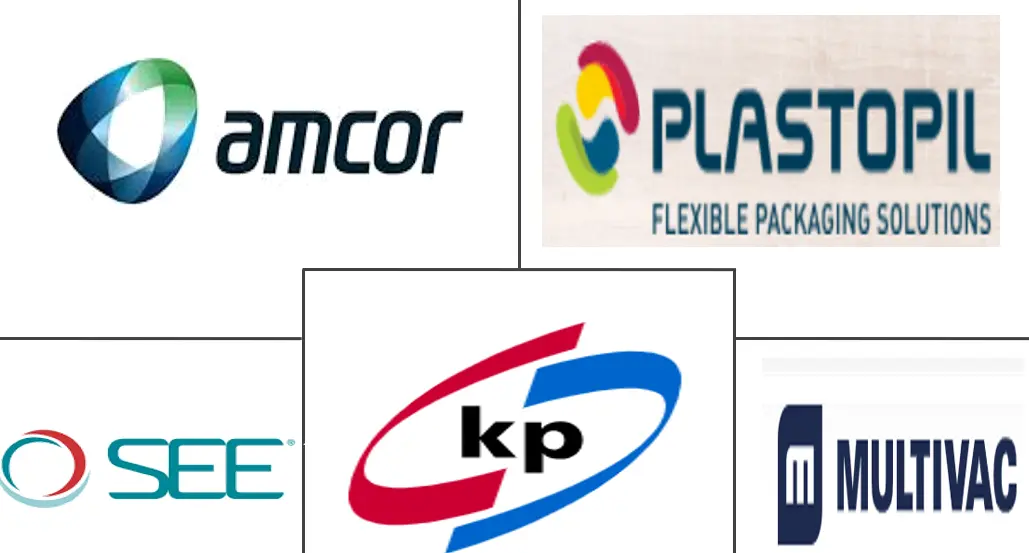Skin Packaging Market Size and Share
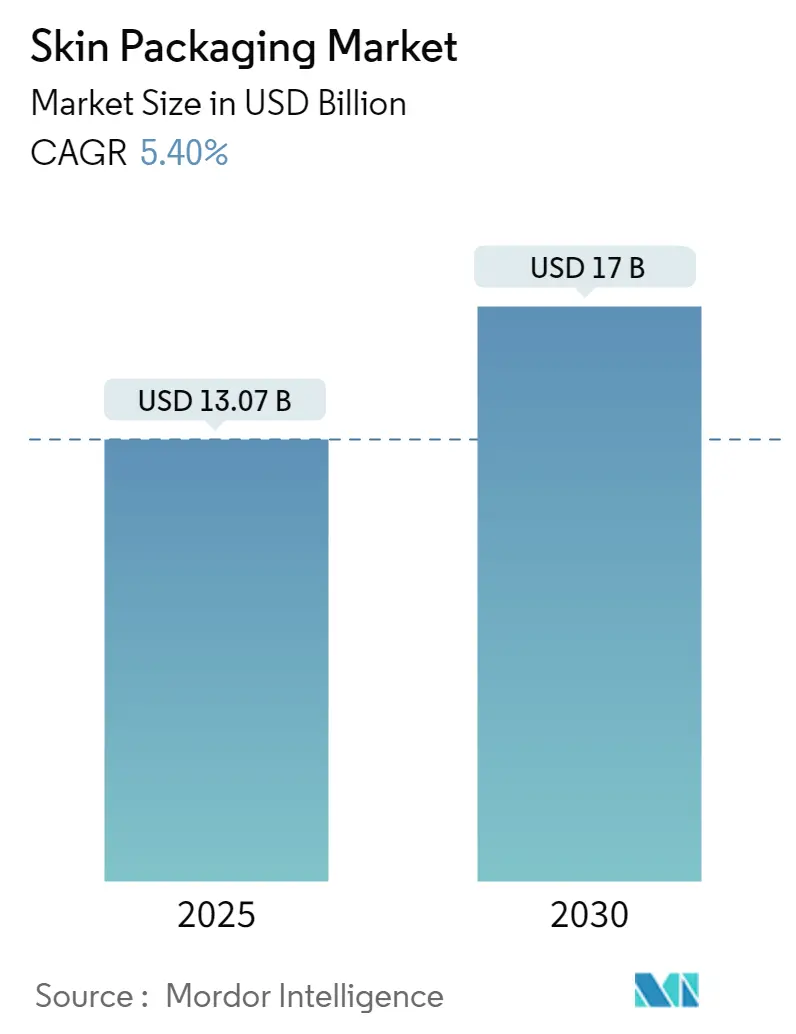
Skin Packaging Market Analysis by Mordor Intelligence
The Skin Packaging Market size is worth USD 13.07 Billion in 2025, growing at an 5.40% CAGR and is forecast to hit USD 17 Billion by 2030.
- Skin packaging is a state-of-the-art technique consisting of thin layers of plastic film over a thermoforming tray or manufactured plastic container. In addition to allowing customers to look at the product without any risk of contamination, this plastic film provides a very transparent layer of protection against air and moisture that may degrade products or cause them to spoil.
- The growing need to protect food, increase shelf life, reduce waste, and increase visibility is raising the demand for skin packaging from the food industry since it offers benefits, such as reliability, with durable trays, which support and protect products during shipping, storage, and display.
- The growing demand for the preservation of various meat and dairy products, such as cheese, cold cuts, and various forms of beef, is driving the skin packaging market. As vacuum skin packaging provides better durability, traditional packaging techniques have been phased out in various food industry applications in recent years. Moreover, it provides an additional layer that protects the food compared to conventional packaging solutions, increasing its adoption and supporting market growth.
- The demand for skin packaging has increased globally due to the growing understanding of the advantages of recycling and bioplastics. Key market drivers include the abundance of raw materials and the quickening pace of technical developments in the skin packaging market.
- According to the Packaging Industry Association of India (PIAI), the Indian skin packaging market will be worth more than USD 204.81 billion by the end of 2025. The market will continue to develop throughout the forecast period due to rising per capita spending and growing demand for superior products with flexible plastic packaging that is light and durable and can provide protection against contamination.
- In part, the market is driven by consumers wanting longer shelf life and better visibility of products. Skin packaging offers better product protection, preserving the integrity and freshness of the goods. It also gives the goods better visibility so that consumers can see the actual product and its characteristics, which may motivate purchases.
- Since electronic products and components are sensitive to water, they require protective armor. Hence, the demand for skin packaging is high due to its water-resistant properties. It also helps protect the body from damage and scratches in electrical products. Furthermore, industrial goods, such as tools and automotive parts, are prone to body damage and are exposed to dynamic weather conditions, increasing the need for skin packaging in different industrial goods packaging applications.
- Sustainable packaging is the future, and the quest for eco-friendly alternatives is a top priority in the food industry. Fresh meat packaging made from conventional plastic is facing pressure; hence, the industry is shifting toward eco-friendly solutions. In April 2023, Stora Enso's new Trayforma BarrPeel (barrier-coated paperboard for vacuum skin packaging) aimed to enable perishable products to be packaged in recyclable paperboard trays, reducing the overall plastic content of packaging to less than 10%.
- The fluctuating prices of raw materials and stringent regulations imposed by the government on the application of plastic for food packaging are likely to restrain market growth. The availability of environmentally friendly alternatives and rising environmental concerns are further expected to hamper market growth.
Global Skin Packaging Market Trends and Insights
The Meat Sub-segment Under Food is Expected to Hold a Major Market Share
- Skin packaging is a recent method of meat storage derived from traditional vacuum packaging. This method involves placing raw meats on a plastic tray and then covering them with a thermoformed plastic film that is heated simultaneously while the meat is being positioned. This process ensures that the upper skin is precisely shaped by shrinking it, thus preventing the formation of air and reducing the likelihood of visible exudation, increasing the product’s shelf-life.
- This technique was created to commercialize small amounts of raw, minced, or meat preparations that can be bought in a retail store. The close fixation of the plastic film on the product also has the finality to enhance all sensory aspects perceived by the consumer since this technique is mainly used for self-service purchases.
- Skin packaging is becoming increasingly common in supermarkets and other retail outlets to extend expiration dates and minimize food loss, supported by the increased awareness of the UN Sustainable Development Goals (SDGs). As meat blocks tend to remain on the shelves long before being purchased, the skin packaging method is primarily used for blocks of meat rather than sliced meat for household consumption and other products.
- The ability to resist bone punctures and increase shelf life, hold the product in place, and protect the meat during distribution, as well as the clarity of the film that allows consumers to see the product, are the main characteristics of skin films. Aside from its advantages for merchandising and shelf life, the skin packaging seal's size reduces meat waste and returns. There can be many returns from retailers due to leaks or packages with poor seals, especially in the meat industry.
- The demand for meat and cut meat packaging is rapidly increasing due to the e-commerce boom, and it is expected to be constant during the forecast period. According to the Organisation for Economic Co-operation and Development data, poultry meat consumption worldwide is expected to reach 147.47 metric kilotons in 2028, an increase from 135.62 metric kilotons in 2022. Thus, due to the increasing consumption of meat products, there is a constant need for skin packaging.
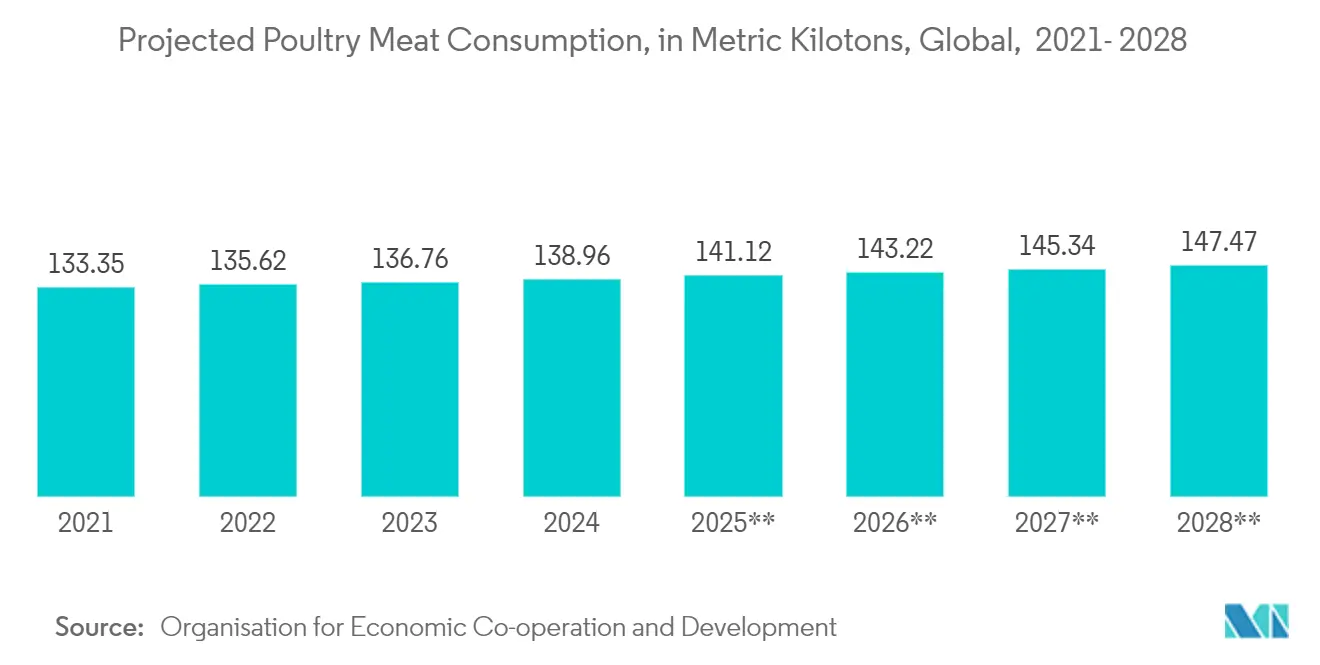
Asia-Pacific is Expected to Hold Significant Share of the Market
- Due to the expanding organized retail and e-commerce sectors and the simplicity with which raw materials can be obtained, Asia-Pacific is anticipated to present prospective growth possibilities for market players. The demand for packaged food goods is expected to increase due to the rising consumer buying power in China, India, and Indonesia, which would boost market expansion.
- China’s skin packaging industry is growing due to the country's booming economy, rapid urbanization, and rising standard of living. Consumers gravitate toward more secure, practical, distinctive, and environmentally responsible packaging. According to the National Bureau of Statistics of China, approximately 63.9% of China's total population resides in cities. China has experienced a steady increase in its urbanization rate over the past few decades.
- Companies are extending their presence in Asia-Pacific as the region continues to develop. For instance, Amcor, a leader in responsible packaging solutions, opened its brand-new, cutting-edge production facility in Huizhou, China. The 590,000 square foot factory, which cost over USD 100 million to build, is China's largest flexible packaging facility in terms of production capacity, enhancing Amcor's capabilities to fulfill rising client demand throughout Asia-Pacific.
- The rising population, rising income levels, and changing lifestyles are expected to increase consumer spending, raising the demand for skin packaging products in India. Moreover, the increased media penetration via the Internet and television is boosting the demand from the rural sector for packaged goods.
- With increased demand and the emergence of new businesses in the food and beverage industry, India witnessed a surge in the packaging used for food and beverages. Food and beverage packaging use has increased due to the launch and rapid expansion of food delivery services like Zomato and Swiggy. There have been considerable advancements in food packaging that emphasize brand recognition while upholding the caliber and level of the food product with contain skin packs.
- With the growing population and urbanization, the demand for meat in China is growing significantly, which impacts the demand for different types of skin packaging for meat to keep it fresh and tender for a longer duration. According to the Organisation for Economic Co-operation and Development, per capita meat consumption in China showed a growing trend. It was 45.17 kilograms in 2021, which increased to 48.28 kilograms in 2023; it is expected to reach 52.84 kilograms by 2029.
- The market is driven by the growing preference of Chinese customers for meat, cheese items, fish, pork, seafood, vegetables, and others that are mostly skin-packed to make them shelf-stable. Customers in the nation are becoming increasingly accustomed to purchasing fresh fish and seafood.
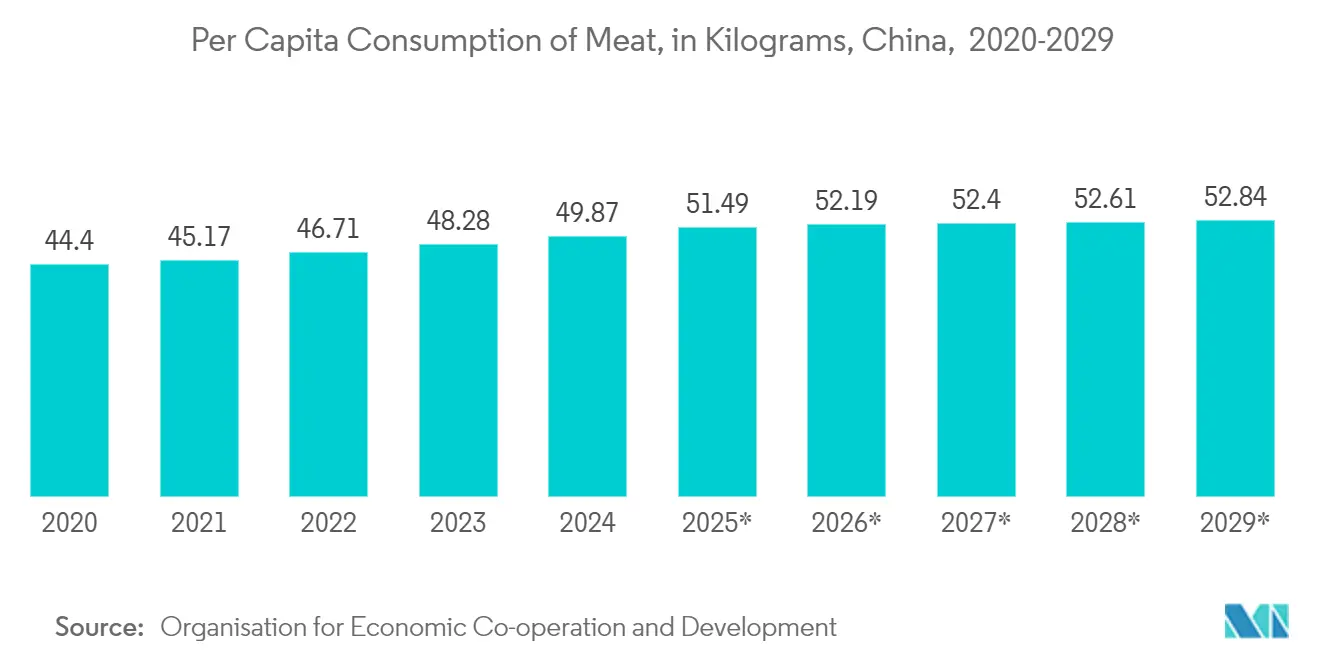
Competitive Landscape
The competitive landscape of the skin packaging market is fragmented, consisting of several players like Amcor Group GmbH, Sealed Air Corporation, Clondalkin Flexible Packaging Orlando Inc., and Plastopil Hazorea Co. Increased R&D spending by market participants leads to product differentiation, which is a strategy to secure a competitive advantage.
Skin Packaging Industry Leaders
-
Plastopil Hazorea Co. Ltd
-
Sealed Air Corporation
-
Amcor Group GmbH
-
MULTIVAC Sepp Haggenmller SE & Co. KG
-
Klockner Pentaplast Ltd
- *Disclaimer: Major Players sorted in no particular order
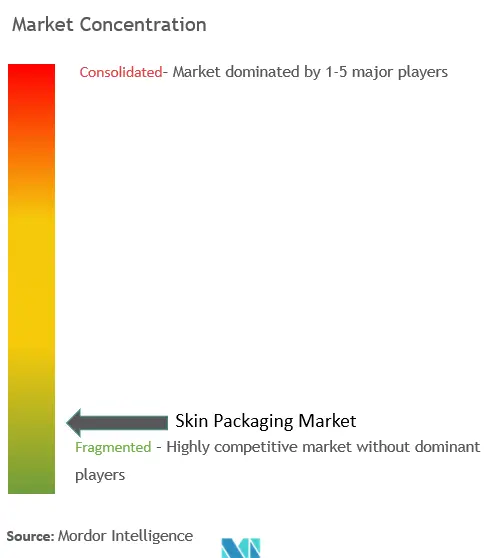
Recent Industry Developments
- January 2024: Sealed Air Corporation developed a new paper-based bottom web to support food processors and retailers in reducing plastic usage and meeting consumer demand for paper packaging. CRYOVAC's new Barrier Formable Paper, composed of 90% FSC-certified fibers, can reduce plastic usage in bottom web packaging by 77% when substituting PET/PE webs.
- April 2023: Amcor partnered with Tyson Foods, one of the largest food companies and a recognized global protein leader, to provide more sustainable packaging for consumer products. The partnership brought together two industry players in sustainability to create innovative solutions that deliver more sustainable packaging without sacrificing performance. Tyson Foods Jimmy Dean Egg Bites and Frittatas are wrapped in Amcor's flexible AmPrima recycled film. The design and development of the packs consider more than just sustainability requirements. Amcor R&D led the development of customized films to achieve cost-effective results.
Global Skin Packaging Market Report Scope
Skin packaging is carded packaging in which a product is placed on a piece of paperboard, and a thin sheet of transparent plastic is over the product and paperboard. The printed paperboard usually includes a heat-seal coating; customers can see through the plastic without contamination. Skin packaging is a product packaging method that involves applying heat to a thin plastic sheet or film. Skin packaging solutions provide total product safety, complete lockdown product protection, and complete product visibility.
The skin packaging market is segmented by application (food (meat, fish, and seafood, processed food, and cheese), industrial goods (electronic and electrical components), medical devices, and durable consumer goods) and geography (North America (the United States, Canada), Europe (Germany, France, the United Kingdom, and Rest of Europe), Asia-Pacific (China, India, Japan, Australia and New Zealand, and Rest of Asia-Pacific), Latin America (Brazil, Mexico, and Rest of Latin America), and Middle East and Africa (the United Arab Emirates, Saudi Arabia, South Africa, and Rest of Middle East and Africa). The market sizes and forecasts are provided in terms of value (USD) for all the above segments.
| Food | Meat |
| Fish and Seafood | |
| Processed Food | |
| Cheese | |
| Industrial Goods (Including Electronic and Electrical Components) | |
| Medical Devices | |
| Durable Consumer Goods |
| North America | United States |
| Canada | |
| Europe | United kingdom |
| France | |
| Germany | |
| Asia | China |
| Japan | |
| India | |
| Australia and New Zealand | |
| Latin America | Brazil |
| Mexico | |
| Middle East And Africa | Saudi Arabia |
| United Arab Emirates | |
| South Africa |
| By Application | Food | Meat |
| Fish and Seafood | ||
| Processed Food | ||
| Cheese | ||
| Industrial Goods (Including Electronic and Electrical Components) | ||
| Medical Devices | ||
| Durable Consumer Goods | ||
| By Geography *** | North America | United States |
| Canada | ||
| Europe | United kingdom | |
| France | ||
| Germany | ||
| Asia | China | |
| Japan | ||
| India | ||
| Australia and New Zealand | ||
| Latin America | Brazil | |
| Mexico | ||
| Middle East And Africa | Saudi Arabia | |
| United Arab Emirates | ||
| South Africa | ||
Key Questions Answered in the Report
How big is the Skin Packaging Market?
The Skin Packaging Market size is worth USD 13.07 billion in 2025, growing at an 5.40% CAGR and is forecast to hit USD 17 billion by 2030.
What is the current Skin Packaging Market size?
In 2025, the Skin Packaging Market size is expected to reach USD 13.07 billion.
Who are the key players in Skin Packaging Market?
Plastopil Hazorea Co. Ltd, Sealed Air Corporation, Amcor Group GmbH, MULTIVAC Sepp Haggenmller SE & Co. KG and Klockner Pentaplast Ltd are the major companies operating in the Skin Packaging Market.
Which is the fastest growing region in Skin Packaging Market?
Asia Pacific is estimated to grow at the highest CAGR over the forecast period (2025-2030).
Which region has the biggest share in Skin Packaging Market?
In 2025, the North America accounts for the largest market share in Skin Packaging Market.
What years does this Skin Packaging Market cover, and what was the market size in 2024?
In 2024, the Skin Packaging Market size was estimated at USD 12.36 billion. The report covers the Skin Packaging Market historical market size for years: 2019, 2020, 2021, 2022, 2023 and 2024. The report also forecasts the Skin Packaging Market size for years: 2025, 2026, 2027, 2028, 2029 and 2030.
Page last updated on:
Skin Packaging Market Report
Statistics for the 2025 Skin Packaging market share, size and revenue growth rate, created by Mordor Intelligence™ Industry Reports. Skin Packaging analysis includes a market forecast outlook for 2025 to 2030 and historical overview. Get a sample of this industry analysis as a free report PDF download.
